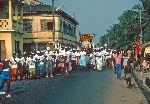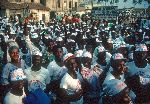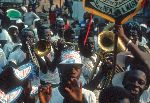|
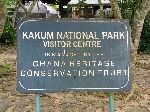 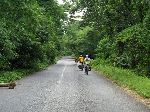 Ghana's
most significant national park, near the coast, is Kakum National Park. The
entrance is about 40 kilometer inland from Cape Coast on the Twifo Praso road.
The biggest amusement at the park is the canopy walk. Presumably it provides a
better opportunity to learn about the park, but in hearing dozens of
people returning from the canopy walk, none were talking about how it was a
means to a better understanding of the forest flora and fauna, but there was
a lot talk about it Ghana's
most significant national park, near the coast, is Kakum National Park. The
entrance is about 40 kilometer inland from Cape Coast on the Twifo Praso road.
The biggest amusement at the park is the canopy walk. Presumably it provides a
better opportunity to learn about the park, but in hearing dozens of
people returning from the canopy walk, none were talking about how it was a
means to a better understanding of the forest flora and fauna, but there was
a lot talk about it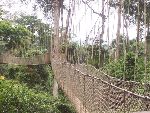 as the attraction in itself. This is strikingly similar to canopy walks in
parts of the world where rarely do they provide an enhances opportunity for
seeing an wildlife -- perhaps because there is just too darn high a
concentration of clamoring people on them, which creates a wildlife-free
zone-- but they are a nice income
generating amusement to support other park initiatives. In Kakum National Park, an hour
of canopy walking, for a foreigner, cost 30 Ghana cedis (~UD$20).
as the attraction in itself. This is strikingly similar to canopy walks in
parts of the world where rarely do they provide an enhances opportunity for
seeing an wildlife -- perhaps because there is just too darn high a
concentration of clamoring people on them, which creates a wildlife-free
zone-- but they are a nice income
generating amusement to support other park initiatives. In Kakum National Park, an hour
of canopy walking, for a foreigner, cost 30 Ghana cedis (~UD$20).
If your interest is flora and fauna you will be better off staying on terra
firma and going on a guided forest walk for half the price. Kakum forest was
logged at one point so it is not as grand as it would have been before
commercial logging began, but it has been protected since about 1960 so it is
now
filling out. The forest guide makes a number of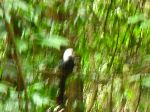 stops to discuss the history of the park, the flora and fauna and ethno-botany
of some of the significant species. We got a fairly nice look at what was
probably a White-Crested Touraco (left), though the Collins Field Guide doesn't
indicate that is should be found anywhere near this area and the camera didn't
have a lens at all suitable for bird photography.
stops to discuss the history of the park, the flora and fauna and ethno-botany
of some of the significant species. We got a fairly nice look at what was
probably a White-Crested Touraco (left), though the Collins Field Guide doesn't
indicate that is should be found anywhere near this area and the camera didn't
have a lens at all suitable for bird photography.
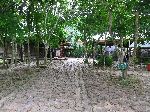 For
those who are interested, there are rustic accommodations in the park and there
is a small restaurant with reasonable prices (and limited hours) at For
those who are interested, there are rustic accommodations in the park and there
is a small restaurant with reasonable prices (and limited hours) at the visitor
center. If you're traveling light and don't want to have to rely on cooking
your own food, but want to stay in the park past several meal this is an option. The
restaurant has the popular, but not always common dish, Red-Red
– a plate of beans and fried plantain, and sometimes fish (right). If you want the
restaurant to provide you with an evening meal it is advised to place your
order in the early afternoon. the visitor
center. If you're traveling light and don't want to have to rely on cooking
your own food, but want to stay in the park past several meal this is an option. The
restaurant has the popular, but not always common dish, Red-Red
– a plate of beans and fried plantain, and sometimes fish (right). If you want the
restaurant to provide you with an evening meal it is advised to place your
order in the early afternoon.
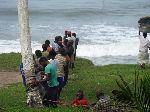 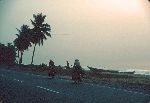 Besides
being picturesque the beauty of arriving at the coast is the breeze gives the environment a freshness.
The sea obviously plays a major role in the people's lives. The shore is
dotted with boats for miles and it is a rare morning that you can't see a team
hauling in a fishing net. The nets are set in a large arc by boats and then
dragged into shore over the course of hours. The team will pull for ten or
fifteen minutes, then take a break, before recommencing with the toil. Besides
being picturesque the beauty of arriving at the coast is the breeze gives the environment a freshness.
The sea obviously plays a major role in the people's lives. The shore is
dotted with boats for miles and it is a rare morning that you can't see a team
hauling in a fishing net. The nets are set in a large arc by boats and then
dragged into shore over the course of hours. The team will pull for ten or
fifteen minutes, then take a break, before recommencing with the toil.
 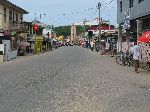 Elmina
is often in the shadow of its larger neighbor 20 km to the east, Cape Coast, but its beautiful
setting, accessible size, friendly disposition, and high concentration of points
of interest,
including the harbor, two forts, a half-dozen Posuban Shines, several bicycle
shops and the coastline) make it a a more desirable place to spend time to me. Elmina
is often in the shadow of its larger neighbor 20 km to the east, Cape Coast, but its beautiful
setting, accessible size, friendly disposition, and high concentration of points
of interest,
including the harbor, two forts, a half-dozen Posuban Shines, several bicycle
shops and the coastline) make it a a more desirable place to spend time to me.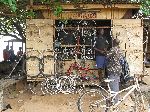
We visited bicycle shops every day or two around the country, including in
Elmina. The universally has a limited inventory of tools and supplies, but
across the board they were as friendly and helpful as far as their resources
allowed, and often beyond.
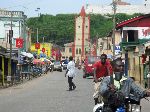 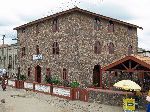 The
economy
seem to be reasonable healthy in Elmina. A number of building have fresh coats of paint,
traffic bustles and a couple significant older buildings have been restored and
given new active lives. The
economy
seem to be reasonable healthy in Elmina. A number of building have fresh coats of paint,
traffic bustles and a couple significant older buildings have been restored and
given new active lives.
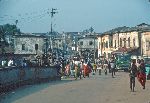 The
photo left and right (below), The
photo left and right (below),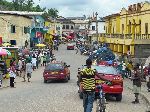 are from the same section of street
twenty-five years apart, in
1986 and 2011, respectively. The white building in the right-center of the left
photo is the yellow building on the right of the right photo. Adjacent to
the yellow building (to the right, out of the picture) is the stone building
(above right), which has also been are from the same section of street
twenty-five years apart, in
1986 and 2011, respectively. The white building in the right-center of the left
photo is the yellow building on the right of the right photo. Adjacent to
the yellow building (to the right, out of the picture) is the stone building
(above right), which has also been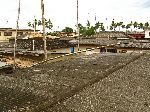
 beautifully renovated and is now a seaside
restaurant. The town has also spread to the west and the north. In
1986, the strip of land between the harbor and coast (left) used to have a few
scattered coconut palms, but but by 2011 it was filled with buildings (right). beautifully renovated and is now a seaside
restaurant. The town has also spread to the west and the north. In
1986, the strip of land between the harbor and coast (left) used to have a few
scattered coconut palms, but but by 2011 it was filled with buildings (right).

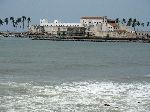
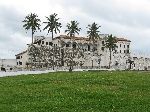
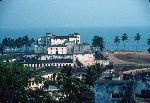 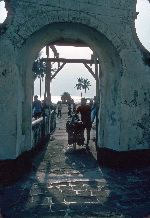 Elmina
is best known for its "castle." It was originally built by the
Portuguese in 1482 as São Jorge da Mina (St. George of the Mine) Castle.
It was the first Elmina
is best known for its "castle." It was originally built by the
Portuguese in 1482 as São Jorge da Mina (St. George of the Mine) Castle.
It was the first
 trading post built on the Gulf of Guinea, so it is the oldest
European building in existence south of the Sahara. It was first established for
goods trade, the castle later became one of the most important stops on the
route trading post built on the Gulf of Guinea, so it is the oldest
European building in existence south of the Sahara. It was first established for
goods trade, the castle later became one of the most important stops on the
route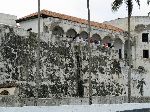 of the Atlantic slave trade. The Dutch seized the fort from the Portuguese
in 1637. Control of the Castle and the slave trade continued under the Dutch
until 1814. In 1871, the Dutch Gold Coast, including the fort, became a
possession of the British Empire. of the Atlantic slave trade. The Dutch seized the fort from the Portuguese
in 1637. Control of the Castle and the slave trade continued under the Dutch
until 1814. In 1871, the Dutch Gold Coast, including the fort, became a
possession of the British Empire.
 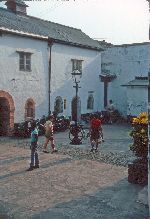 There is also second fort in Elmina, Fort St Jago, on the next hill over.
It doesn't get the attention that Ft St George gets, perhaps because it is
smaller and doesn't have a direct connection to slavery. Around 1503 the
Portuguese built a church on the hill. In 1637 There is also second fort in Elmina, Fort St Jago, on the next hill over.
It doesn't get the attention that Ft St George gets, perhaps because it is
smaller and doesn't have a direct connection to slavery. Around 1503 the
Portuguese built a church on the hill. In 1637
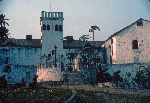 the
Dutch set-up a gun position
on the hill to bombard Ft St Jorge, and eventually take it from the Portuguese.
The hill was further fortified in 1638 and the 1660's.
The stone fort, named Coenraadsburg, is unique as “the
oldest purely military architecture of the Gold Coast". It
had no commercial warehouses of any kind and its
military fortifications were based on
the design of baroque
military architecture. Its main features comprised
two giant, the
Dutch set-up a gun position
on the hill to bombard Ft St Jorge, and eventually take it from the Portuguese.
The hill was further fortified in 1638 and the 1660's.
The stone fort, named Coenraadsburg, is unique as “the
oldest purely military architecture of the Gold Coast". It
had no commercial warehouses of any kind and its
military fortifications were based on
the design of baroque
military architecture. Its main features comprised
two giant,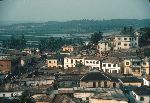 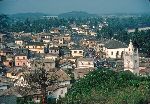 strong landward bastions on the
northeast and northwest sides for defending the
castle from land
attacks and two smaller seaward bastions on the southwest and southeast sides.
It offers a commanding view of the surrounding countryside.
strong landward bastions on the
northeast and northwest sides for defending the
castle from land
attacks and two smaller seaward bastions on the southwest and southeast sides.
It offers a commanding view of the surrounding countryside.
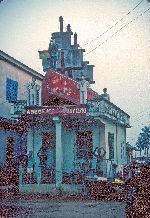 Unique to
the central and western coastal region
of Ghana and a bit of eastern coastal Ivory Coast, Posuban houses are
elaborate concrete shrines in the urban areas of Fante settlements. These
shrines are the work of Asafo companies. Asafo companies are the patrilineal military units that
are a feature of most Akan societies.
Once they were responsible for the defense of the town, but now they are are more ceremonial
and cultural. Unique to
the central and western coastal region
of Ghana and a bit of eastern coastal Ivory Coast, Posuban houses are
elaborate concrete shrines in the urban areas of Fante settlements. These
shrines are the work of Asafo companies. Asafo companies are the patrilineal military units that
are a feature of most Akan societies.
Once they were responsible for the defense of the town, but now they are are more ceremonial
and cultural.
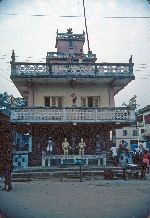 Many
Posubans originated as storage houses for arms and
company regalia. While the actual sites are quite ancient, their present
form date at least from the colonial period and probably mostly post-independence. Many
Posubans originated as storage houses for arms and
company regalia. While the actual sites are quite ancient, their present
form date at least from the colonial period and probably mostly post-independence.
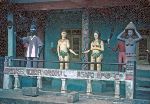 The
design, though African, don't seem to have strong traditional roots and
draws seemingly randomly on western culture and mythology for most of the
imagery. One of Elmina's Posuban has a European-style ship on the roof and a very nautical
theme. Another building includes figures of Adam and Eve and mermaids. The
design, though African, don't seem to have strong traditional roots and
draws seemingly randomly on western culture and mythology for most of the
imagery. One of Elmina's Posuban has a European-style ship on the roof and a very nautical
theme. Another building includes figures of Adam and Eve and mermaids.
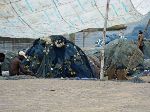  Being
a fishing town, there are fishing nets and boat paraphernalia all over town
and the towns harbor is filled with boats. Blue and red seem to be the
preferred color, but there is enough yellow and green in the mix to make it
a colorful place. Being
a fishing town, there are fishing nets and boat paraphernalia all over town
and the towns harbor is filled with boats. Blue and red seem to be the
preferred color, but there is enough yellow and green in the mix to make it
a colorful place.
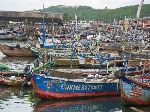
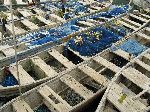
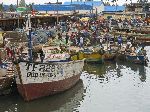 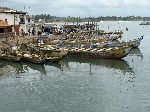
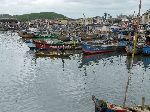
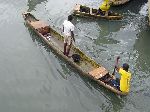
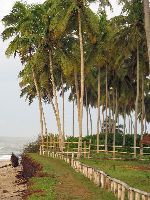  Local
entrepreneurs have developed a number of lodging options along the coast.
Many seem overbuilt, over manicured, and culturally sterile -- almost turning there back on
the coast and beautiful natural Local
entrepreneurs have developed a number of lodging options along the coast.
Many seem overbuilt, over manicured, and culturally sterile -- almost turning there back on
the coast and beautiful natural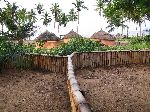 environment. That
certainly is not a description of Stumble Inn. The buildings are simple
and fit with the land and culture and the lot sits right on the ocean. It
is a very relaxing bit of tropical paradise. environment. That
certainly is not a description of Stumble Inn. The buildings are simple
and fit with the land and culture and the lot sits right on the ocean. It
is a very relaxing bit of tropical paradise.
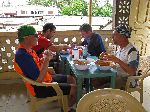 After
a hard day of tourism it is always nice to relax with a good meal. The
"hard day of tourism" might be a stretch, but we had plenty of good meals.
Some of the stars of a Ghanaian menu are: Ampesi (a plate of either boiled yam,
plantain, cocoyam, cassava; any two or all of them served with stew / gravy /
kontomire or thick palm-nut soup), Fufu (assava, plantain, yam, cocoyam and/or
rice, pounded into a glutinous mass and served with soup), Jollof rice (a
simplification of Senegalese thieboudienne, flavored rice with fish,
chicken or meat), Kelewele (spice fried plantain), and Waakye (rice and beans). After
a hard day of tourism it is always nice to relax with a good meal. The
"hard day of tourism" might be a stretch, but we had plenty of good meals.
Some of the stars of a Ghanaian menu are: Ampesi (a plate of either boiled yam,
plantain, cocoyam, cassava; any two or all of them served with stew / gravy /
kontomire or thick palm-nut soup), Fufu (assava, plantain, yam, cocoyam and/or
rice, pounded into a glutinous mass and served with soup), Jollof rice (a
simplification of Senegalese thieboudienne, flavored rice with fish,
chicken or meat), Kelewele (spice fried plantain), and Waakye (rice and beans).
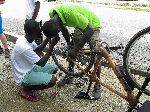 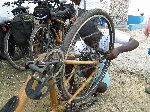 A
typical part of a bicycle tour is the practice of self sufficiency. Here
the wheel is giving us a little test. At least for the moment we passed
the test and bicycled on to the more fun, adventure and enrichment. A
typical part of a bicycle tour is the practice of self sufficiency. Here
the wheel is giving us a little test. At least for the moment we passed
the test and bicycled on to the more fun, adventure and enrichment.
 Cape
Coast is the home of Cape Coast University (left) and Cape Coast Castle (right). Cape
Coast is the home of Cape Coast University (left) and Cape Coast Castle (right).

Cape Coast University is one of five major universities in Ghana, with about
15,000 undergraduate students on campus.
The first fort on the site of Cape
Coast Castle was built by the Swedes in 1653. Ten years later all of the
Swedish holdings on the Gold Coast were seized by the Danish. A year later the
Castle
was conquered by the British and extensively rebuilt. The Castle original
purpose was
for the trade in timber and gold. Later the structure, and it large storage
rooms, was used in the
trans-Atlantic slave trade.
 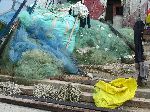 Being
the big city in the area, Cape
Coast has a broader range of economic activity than the more rural areas of the
central coast, but fishing is still a significant part of the mix. There are piles
of fishing nets stacked at various places near the shore and unoccupied parking lots
are used to repair them. Being
the big city in the area, Cape
Coast has a broader range of economic activity than the more rural areas of the
central coast, but fishing is still a significant part of the mix. There are piles
of fishing nets stacked at various places near the shore and unoccupied parking lots
are used to repair them.
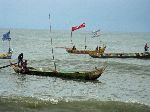 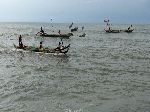 On
this day there was also a bit of a boat regatta. They weren't acting like
they were fishing and they weren't moving like there were racing, but they were
clustered and decorated with pennants and flags, including one boat flying an
Israeli flag. On
this day there was also a bit of a boat regatta. They weren't acting like
they were fishing and they weren't moving like there were racing, but they were
clustered and decorated with pennants and flags, including one boat flying an
Israeli flag.
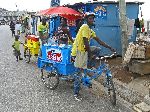 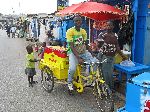 In
this pair of photos from Cape Coast, Maggi (a bouillon-type spice used to flavor
soups and sauces) and Cerelac (an easily-digested instant cereal) are
advertised with painted tri-cycle. The operators said they didn't have any
merchandise for sale nor as samples. Both brands are owned by Nestle
Corporation. In
this pair of photos from Cape Coast, Maggi (a bouillon-type spice used to flavor
soups and sauces) and Cerelac (an easily-digested instant cereal) are
advertised with painted tri-cycle. The operators said they didn't have any
merchandise for sale nor as samples. Both brands are owned by Nestle
Corporation.
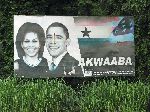
President and Michelle Obama visited Ghana on the President's first official
trip to Ghana, in July 2009. Along his motorcade route, along the coast,
of a number of signs welcoming him and singing his praises. Two years
later it is doubtful that any have been taken down, but some are getting
significantly weathered.
 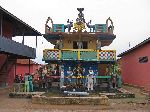 Mankessim
is the traditional paramouncy for all the Fantse-speaking people and is linked
to the Nananom Pow (sacred grove) near Obidan, but an outside won't get a clue
of that driving through. Mankessim is also said to have a number of
cultural performing groups that helps to preserve and promote its rich cultural
heritage. Mankessim
is the traditional paramouncy for all the Fantse-speaking people and is linked
to the Nananom Pow (sacred grove) near Obidan, but an outside won't get a clue
of that driving through. Mankessim is also said to have a number of
cultural performing groups that helps to preserve and promote its rich cultural
heritage.
Driving through, mostly you are aware that it is large market area where two
major roads come together -- the coastal highway and a road into the interior
that can be taken to Kumasi and beyond.
One significant point of interest, even to an outsider, is a large Posuban
shrine. It is tucked away in a neighborhood a half-kilometer north of the
traffic circle. The art, though African, draws on western themes, looking
somewhat out of place in traditional Africa. Among the decorations in Makessim are cannons, horseman, birds, lions, officials, the three warriors
Obrumankoma, Odapagyan and Oson – who helped the people's migration from
Takyiman in the current Brong Ahafo region to Adoagyir in the Central
region, deer, coat-of-arms, and some on lookers.
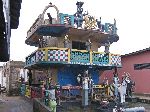
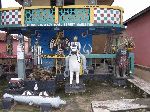
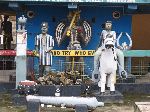
|




























































